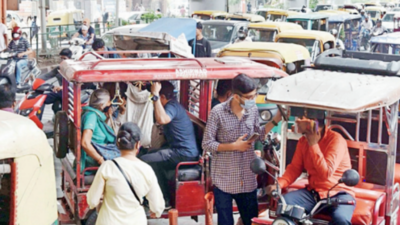Top Searches
- News
- City News
- delhi News
- ...Delhi Metro to find way out of Karol Bagh maze

E-rickshaws can be seen clogging traffic on the arterial Pusa Road, where Karol Bagh Metro Station is located
NEW DELHI: Located around half a kilometre from one of Delhi’s most popular markets, the area outside Karol Bagh Metro Station buzzes with activity almost throughout the day, mostly caused by a large congregation of e-rickshaws.
Though an eco-friendly and affordable mode of last-mile connectivity, e-rickshaws lead to chaos outside the station. Delhi Metro Rail Corporation (DMRC) has now chalked out a plan to decongest the area.

E-rickshaws can be seen clogging traffic on the arterial Pusa Road, where Karol Bagh Metro Station is located. They are often being seen driven haphazardly and even going against the flow of traffic to avoid taking detours. Though there are plastic bollards to segregate e-rickshaws from other traffic, they not only take up more than one lane, but run over the bollards.
Karol Bagh is a part of 10 stations where DMRC and Delhi government’s Public Works Department (PWD) have initiated the process of carrying out multi-modal integration (MMI).
According to DMRC’s own findings, four out of 10 commuters access Karol Bagh Metro Station through e-rickshaws (39%) and rickshaws (1%). The MMI project would ensure that pedestrians get in and out of the station seamlessly without manoeuvring cabs, autorickshaws, e-rickshaws, etc.
Railing and fencing would be installed to streamline and guide pedestrian movement towards queue parking for e-rickshaws, rickshaws, autorickshaws, etc. Footpaths would be widened to a minimum two metres on every road and proper signage would be installed to ensure proper usage of parking facilities.
The plan proposes to have enough bays to accommodate 50 e-rickshaws at a time, apart from 30 bays for autorickshaws. While many bays for these already exist, 34 new bays for cycles as part of a public bike-sharing system would also be installed. Two drop-off points for app-based cabs would also be created outside the Metro station.
DMRC would provide the public bike-sharing stand, along with the drop-off point for cabs and an autorickshaw stand, while PWD would work on the dedicated lane for e-rickshaws. PWD would also provide “channelisers” to segregate different lanes on the road outside the station. An existing bus stop would be shifted to ensure better traffic movement.
The conceptual plan was prepared by DMRC based on a station survey and the daily footfall of 46,000 at the Metro station.
Though an eco-friendly and affordable mode of last-mile connectivity, e-rickshaws lead to chaos outside the station. Delhi Metro Rail Corporation (DMRC) has now chalked out a plan to decongest the area.

E-rickshaws can be seen clogging traffic on the arterial Pusa Road, where Karol Bagh Metro Station is located. They are often being seen driven haphazardly and even going against the flow of traffic to avoid taking detours. Though there are plastic bollards to segregate e-rickshaws from other traffic, they not only take up more than one lane, but run over the bollards.
Karol Bagh is a part of 10 stations where DMRC and Delhi government’s Public Works Department (PWD) have initiated the process of carrying out multi-modal integration (MMI).
According to DMRC’s own findings, four out of 10 commuters access Karol Bagh Metro Station through e-rickshaws (39%) and rickshaws (1%). The MMI project would ensure that pedestrians get in and out of the station seamlessly without manoeuvring cabs, autorickshaws, e-rickshaws, etc.
Railing and fencing would be installed to streamline and guide pedestrian movement towards queue parking for e-rickshaws, rickshaws, autorickshaws, etc. Footpaths would be widened to a minimum two metres on every road and proper signage would be installed to ensure proper usage of parking facilities.
The plan proposes to have enough bays to accommodate 50 e-rickshaws at a time, apart from 30 bays for autorickshaws. While many bays for these already exist, 34 new bays for cycles as part of a public bike-sharing system would also be installed. Two drop-off points for app-based cabs would also be created outside the Metro station.
DMRC would provide the public bike-sharing stand, along with the drop-off point for cabs and an autorickshaw stand, while PWD would work on the dedicated lane for e-rickshaws. PWD would also provide “channelisers” to segregate different lanes on the road outside the station. An existing bus stop would be shifted to ensure better traffic movement.
The conceptual plan was prepared by DMRC based on a station survey and the daily footfall of 46,000 at the Metro station.
FOLLOW US ON SOCIAL MEDIA
FacebookTwitterInstagram
Looking for Something?

Start a Conversation
end of article

